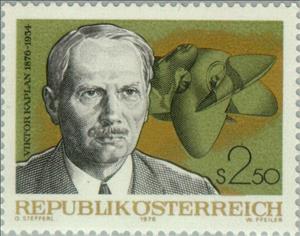Stamp: Viktor Kaplan (1876-1934) engineer, inventor Kaplanturbine (Austria 1976)
Viktor Kaplan (1876-1934) engineer, inventor Kaplanturbine (Austria 1976)
26 November (Austria ) within release Kaplan, Viktor goes into circulation Stamp Viktor Kaplan (1876-1934) engineer, inventor Kaplanturbine face value 2.50 Austrian schilling
| Stamp Viktor Kaplan (1876-1934) engineer, inventor Kaplanturbine in catalogues | |
|---|---|
| Michel: | Mi:AT 1534 |
| Yvert et Tellier: | Yt:AT 1364 |
Stamp is horizontal format.
Stamp Viktor Kaplan (1876-1934) engineer, inventor Kaplanturbine it reflects the thematic directions:
An invention is a unique or novel device, method, composition, idea, or process. An invention may be an improvement upon a machine, product, or process for increasing efficiency or lowering cost. It may also be an entirely new concept. If an idea is unique enough either as a stand-alone invention or as a significant improvement over the work of others, it can be patented. A patent, if granted, gives the inventor a proprietary interest in the patent over a specific period of time, which can be licensed for financial gain.
Engineers, as practitioners of engineering, are professionals who invent, design, analyze, build and test machines, complex systems, structures, gadgets and materials to fulfill functional objectives and requirements while considering the limitations imposed by practicality, regulation, safety and cost.The word engineer (Latin ingeniator, the origin of the Ir. in the title of engineer in countries like Belgium and The Netherlands) is derived from the Latin words ingeniare ("to contrive, devise") and ingenium ("cleverness"). The foundational qualifications of a licensed professional engineer typically include a four-year bachelor's degree in an engineering discipline, or in some jurisdictions, a master's degree in an engineering discipline plus four to six years of peer-reviewed professional practice (culminating in a project report or thesis) and passage of engineering board examinations.

